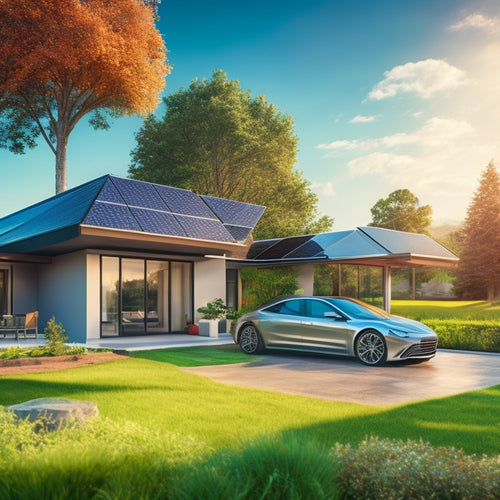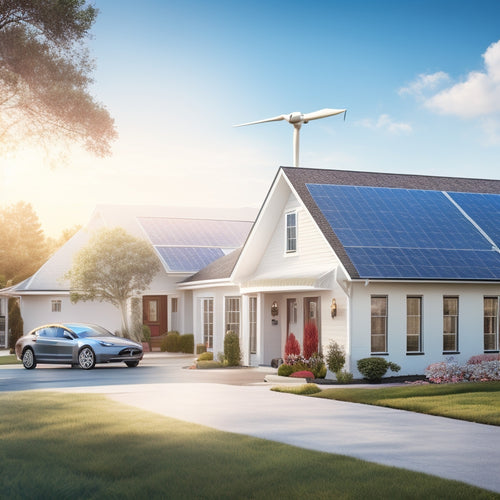
What Are the Hidden Drawbacks of Home Solar?
Share
You're contemplating switching to home solar, but you might not be aware of the hidden drawbacks. The high upfront installation costs, ranging from $15,000 to $30,000 or more, can be a significant financial burden. Intermittent energy production and roof size/space constraints can also impact performance. Plus, you'll need to take into account energy storage and battery limitations, inefficiencies in low-light conditions, and regular maintenance requirements. As you evaluate the benefits of home solar, don't overlook these often-overlooked concerns that can affect your system's efficiency and overall value - there's more to explore on this topic.
Key Takeaways
• High upfront installation costs can be a significant financial burden for homeowners, ranging from $15,000 to $30,000 or more.
• Solar energy's intermittency requires homeowners to manage energy needs during low sunlight or darkness, necessitating demand management strategies.
• Roof constraints, including size, available space, and aesthetic limitations, can hinder solar panel placement and energy production.
• Battery technology limitations, such as limited lifespan and efficiency, can impact the overall performance of home solar systems.
• Regular maintenance, including cleaning, is essential to maintain system efficiency, as panels deteriorate over time due to UV exposure.
High Upfront Installation Costs
While the long-term savings of solar energy can be substantial, you'll first need to tackle the significant upfront cost of installing a solar panel system, which can range from $15,000 to $30,000 or more, depending on the size and quality of the system. This financial challenge can be intimidating, especially for homeowners who are on a tight budget.
The investment hurdles are high, and it may take several years for the system to pay for itself through energy savings. To make matters worse, the cost of installation isn't the only expense you'll need to take into account. You'll also need to factor in the cost of maintenance, repairs, and potential upgrades down the line.
It's crucial to carefully weigh the costs and benefits before making a decision. However, if you're willing to take on the upfront financial burden, the long-term rewards can be significant. Just be prepared to dig deep into your pockets and make some serious financial sacrifices upfront.
Intermittent Energy Source Concerns
As you explore harnessing solar energy, you'll need to address the inherent intermittency of this renewable source, which can leave you without power during periods of low sunlight or darkness. This means you'll need to think about how you'll manage your energy needs during these periods.
The good news is that grid resilience has improved greatly in recent years, allowing for a more stable supply of energy even when the sun isn't shining. However, it's still important to have a plan in place for when the sun dips below the horizon or hides behind clouds.
Demand management plays a vital role in ensuring a seamless energy supply. This involves optimizing energy usage during peak sunlight hours, storing excess energy for later use, and implementing smart grid technologies to balance supply and demand. By doing so, you can minimize the impact of intermittency and guarantee a reliable supply of energy.
It's crucial to weigh these considerations carefully as you explore solar energy for your home.
Roof Size and Space Constraints
You'll need to assess your roof's size and available space to determine how many solar panels can fit, and as a result, how much energy you can generate. This might seem important, but it's essential to take into account the physical constraints of your roof before investing in a solar panel system.
Here are some potential roadblocks to keep in mind:
-
Skylights and vents: You'll need to work around these obstacles to make sure a safe and efficient installation.
-
Chimneys and roof features: Architectural obstacles like chimneys, roof turrets, or unusual roof angles can limit the available space for solar panels.
-
Aesthetic limitations: If you have a historic home or live in a neighborhood with strict architectural guidelines, you might face restrictions on the type and placement of solar panels.
-
Shading issues: Trees, nearby buildings, or other structures can cast shadows on your roof, reducing the amount of energy your solar panels can produce.
-
Roof material and condition: If your roof is old, damaged, or made of a material that's not compatible with solar panels, you might need to replace it before installing a solar panel system.
Energy Storage and Battery Issues
As you consider integrating energy storage into your home solar system, you'll need to think about the limitations of battery technology.
A critical aspect to evaluate is the battery's lifespan, which can be affected by factors like depth of discharge and charging cycles.
Understanding these factors is vital to ensuring your energy storage system operates efficiently and effectively over its lifetime.
Battery Lifespan Concerns
Your solar battery's lifespan is a critical factor in determining the overall cost-effectiveness of your home solar system, with most batteries lasting between 5 to 15 years depending on the type and quality of the battery. However, you should be aware of the limitations that can affect its lifespan.
Here are some key factors worth noting:
-
Cycling limitations: The number of charge/discharge cycles your battery can handle before its capacity starts to degrade. Exceeding this limit can reduce its overall lifespan.
-
Calibration errors: Incorrect calibration can lead to inefficient charging/discharging, reducing the battery's lifespan.
-
Depth of charge: How deeply you drain your battery daily affects its lifespan. Deeper discharges can reduce its lifespan.
-
Environmental factors: Extreme temperatures, humidity, and physical damage can all impact your battery's lifespan.
-
Manufacturing defects: Defects during the manufacturing process can lead to premature battery failure.
Depth of Discharge
When you drain your solar battery to 80% capacity daily, you're effectively reducing its lifespan, as deeper discharges can cause more wear and tear on the battery cells. This is known as the depth of discharge (DOD), and it's important to monitor it to guarantee your battery lasts as long as possible. Aiming for a DOD of 50% or less can greatly increase the cycle life of your battery, which is the number of charge and discharge cycles it can handle before its capacity drops.
| Depth of Discharge (DOD) | Cycle Life | State Monitoring |
|---|---|---|
| 50% | 3,000 - 5,000 cycles | Recommended for ideal battery health |
| 80% | 1,000 - 2,000 cycles | May reduce battery lifespan |
| 100% | <1,000 cycles | Not recommended, may cause severe battery degradation |
Inefficiencies in Low-Light Conditions
Solar panels' energy production decreases noticeably in low-light conditions, leaving you with reduced power output during periods of heavy cloud cover or winter months. If you live in an area with frequent cloudy days or experience winter shading, your solar panels' performance will suffer. This is because solar panels rely on sunlight to generate electricity, and low-light conditions hinder their ability to produce power.
Here are some key points to keep in mind:
-
Cloudy Climates: If you live in an area with frequent cloud cover, your solar panels will produce less energy.
-
Winter Shading: Trees, buildings, or other obstructions can cast shadows on your solar panels, reducing energy production.
-
Reduced Energy Output: Low-light conditions can reduce your solar panels' energy output by up to 50%.
-
Increased Energy Costs: With reduced energy production, you may need to rely more on the grid, increasing your energy costs.
-
System Sizing: Your solar panel system may need to be larger to compensate for low-light conditions, increasing upfront costs.
Keep in mind that these inefficiencies can be mitigated with proper system design and sizing. However, when deciding on a solar panel system for your home, it's crucial to take these factors into account.
Maintenance and Repair Challenges
As you think about installing solar panels on your home, you'll want to take into account the maintenance and repair challenges that can arise.
You'll need to guarantee your panels remain in good condition, as damage can greatly impact energy production, and inverter failures can bring your entire system to a halt.
Regular cleaning is also important, but it's not as easy as just spraying some water - you'll need to think about the complexities of cleaning your panels efficiently.
Panel Damage Risk
As a homeowner, it's crucial to be aware of these potential risks in order to guarantee that your solar panel system operates efficiently.
Here are some common ways your solar panels can get damaged:
-
Debris impact: Falling branches, hail, or other objects can crack or shatter your panels, reducing energy output.
-
Weathering effects like UV degradation, causing panels to deteriorate over time.
-
Manufacturing defects, such as faulty connections or low-quality materials, can lead to premature panel failure.
-
Installation errors, like improper mounting or wiring, can cause panels to malfunction or fail.
-
Animal infestations, like squirrels or birds, can chew on wires or nesting materials, causing damage to your system.
Inverter Failure Rates
Inverters, the heart of your solar panel system, are prone to failure, with average failure rates ranging from 5% to 15% annually, depending on the manufacturer and quality. You might think that's a small risk, but consider the impact of an inverter failure on your grid resilience.
A faulty inverter can lead to power outages, which means you'll be stuck in the dark, literally. And it's not just a matter of flipping a switch; inverter failures can be caused by hot spots, electrical surges, or overheating risks. These issues can be exacerbated by poor cooling systems or low-quality components. Manufacturing flaws can also play a role, making it important to choose a reputable manufacturer.
When an inverter fails, you'll need to shell out for repairs or even replacement, which can be costly. Don't get caught off guard; make sure you understand the warranty and maintenance requirements for your inverter. By being proactive, you can minimize downtime and keep your solar panel system humming along.
Cleaning Complexity
Dust, dirt, and debris can clog your solar panels, reducing their efficiency by up to 25%, making regular cleaning an essential aspect of maintenance.
You might think, 'How hard can it be to clean some panels?' Well, it's not as simple as grabbing a hose and soap. Cleaning your solar panels requires some finesse, especially if you have a large system or live in a dusty area.
Here are some challenges you might face when cleaning your solar panels:
-
Dirty Panels: Dust, dirt, and debris can accumulate quickly, reducing your system's efficiency.
-
Soiled Systems: Debris like leaves, twigs, and bird droppings can clog your system's inverters and connectors.
-
Roof Access: You'll need to safely access your roof to clean your panels, which can be a challenge, especially for larger systems.
-
Specialized Equipment: You may need specialized equipment, like a water-fed pole or a lift, to reach those hard-to-clean areas.
-
Frequency and Scheduling: You'll need to schedule regular cleanings to maintain your system's efficiency, which can be time-consuming and costly.
Frequently Asked Questions
Can I Install Solar Panels on a Rented Property?
You're stuck in a renter's dilemma, wanting to harness solar power but unsure about installing panels on a leased property. Check your lease for restrictions, as you'll need permission from your landlord before going solar.
Do Solar Panels Increase My Property's Resale Value?
When you install solar panels, you'll likely boost your property's resale value, as a higher appraisal process value is often linked to market trends, showing that eco-friendly features are in high demand, which can attract potential buyers.
Are There Any Government Incentives for Solar Panel Installation?
You're in luck! You can snag Federal Credits, covering 26% of installation costs, and sweet State Rebates, which vary by location, making your solar investment even more appealing - and your wallet will thank you!
Can I Use Solar Panels to Charge My Electric Vehicle?
You can use solar panels to charge your electric vehicle, but it's important to guarantee Vehicle Compatibility and peak Energy Efficiency; consider a dedicated EV charging station and a solar panel system that's tailored for your vehicle's specific needs.
Are Solar Panels Resistant to Extreme Weather Conditions?
You'll be relieved to know that solar panels are built to withstand extreme weather conditions! They're designed to resist hail damage and can even survive lightning strikes, ensuring your energy supply remains uninterrupted.
Related Posts
-

What Solar Panels Work Best With EVS Online?
When shopping for solar panels online to power your electric vehicle, look for high-efficiency models that can withst...
-

Charging Points in Rural Areas: 5 Key Insights
When driving through rural areas, you'll face a shortage of charging points, making EV ownership stressful and inconv...
-

Why Homeowners Are Embracing DIY Energy Independence
By taking control of your energy needs, you're breaking free from the uncertainty of utility bills and embracing a se...


